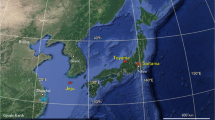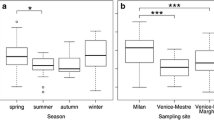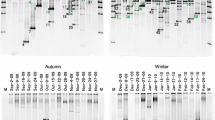Abstract
The most abundant biological particles present in the air are bacteria, fungal propagules and pollen grains. Many of them are proved allergens or even responsible for airborne infectious diseases, which supports the increase of studies in recent years on their composition, diversity, and factors involved in their variability. However, most studies in urban areas are conducted close to ground level and a factor such as height is rarely taken into account. Thus, the information about how the composition of biological particles changes with this variable is scarce. Here, we examined the differential distribution of bacteria, fungi, and plants at four altitudes (up to ∼ 250 m) in a metropolitan area using high-throughput DNA sequencing. Most taxa were present at all levels (common taxa). However, a transitional layer between 80 and 150 m seemed to affect the scattering of these bioaerosols. Taxa not present at all altitudes (non-common) showed an upward tendency of diversity for bacteria and plants with height, while the opposite trend was observed for fungi. Certain patterns were observed for fungi and specific plant genera, while bacterial taxa showed a more arbitrary distribution and no patterns were found. We detected a wide variety of aeroallergens and potential pathogens at all heights, which summed a substantial portion of the total abundance for fungi and plants. We also identified potential connections between the biological particles based on their abundances across the vertical section.




Similar content being viewed by others
References
Després VR, Huffman JA, Burrows SM et al (2012) Primary biological aerosol particles in the atmosphere: a review. Tellus Ser B-Chem Phys Meteorol 64:1. https://doi.org/10.3402/tellusb.v64i0.15598
Bousquet J, Khaltaev N, Cruz AA, Denburg J, Fokkens WJ, Togias A, Zuberbier T, Baena-Cagnani CE, Canonica GW, van Weel C, Agache I, Aït-Khaled N, Bachert C, Blaiss MS, Bonini S, Boulet LP, Bousquet PJ, Camargos P, Carlsen KH, Chen Y, Custovic A, Dahl R, Demoly P, Douagui H, Durham SR, van Wijk R, Kalayci O, Kaliner MA, Kim YY, Kowalski ML, Kuna P, le LT, Lemiere C, Li J, Lockey RF, Mavale-Manuel S, Meltzer EO, Mohammad Y, Mullol J, Naclerio R, O'Hehir RE, Ohta K, Ouedraogo S, Palkonen S, Papadopoulos N, Passalacqua G, Pawankar R, Popov TA, Rabe KF, Rosado-Pinto J, Scadding GK, Simons FE, Toskala E, Valovirta E, van Cauwenberge P, Wang DY, Wickman M, Yawn BP, Yorgancioglu A, Yusuf OM, Zar H, Annesi-Maesano I, Bateman ED, Ben Kheder A, Boakye DA, Bouchard J, Burney P, Busse WW, Chan-Yeung M, Chavannes NH, Chuchalin A, Dolen WK, Emuzyte R, Grouse L, Humbert M, Jackson C, Johnston SL, Keith PK, Kemp JP, Klossek JM, Larenas-Linnemann D, Lipworth B, Malo JL, Marshall GD, Naspitz C, Nekam K, Niggemann B, Nizankowska-Mogilnicka E, Okamoto Y, Orru MP, Potter P, Price D, Stoloff SW, Vandenplas O, Viegi G, Williams D, World Health Organization, GA(2)LEN, AllerGen (2008) Allergic rhinitis and its impact on asthma (ARIA) 2008*. Allergy 63:8–160. https://doi.org/10.1111/j.1398-9995.2007.01620.x
Fronczek CF, Yoon J-Y (2015) Biosensors for monitoring airborne pathogens. J Lab Autom 20:390–410. https://doi.org/10.1177/2211068215580935
Tang JW, Li Y, Eames I, Chan PK, Ridgway GL (2006) Factors involved in the aerosol transmission of infection and control of ventilation in healthcare premises. J Hosp Infect 64:100–114. https://doi.org/10.1016/j.jhin.2006.05.022
Sánchez-Parra B, Núñez A, Moreno DA (2019) Preventing legionellosis outbreaks by a quick detection of airborne Legionella pneumophila. Environ Res 171:546–549. https://doi.org/10.1016/j.envres.2019.01.032
Jones AM, Harrison RM (2004) The effects of meteorological factors on atmospheric bioaerosol concentrations—a review. Sci Total Environ 326:151–180. https://doi.org/10.1016/j.scitotenv.2003.11.021
Innocente E, Squizzato S, Visin F, Facca C, Rampazzo G, Bertolini V, Gandolfi I, Franzetti A, Ambrosini R, Bestetti G (2017) Influence of seasonality, air mass origin and particulate matter chemical composition on airborne bacterial community structure in the Po Valley, Italy. Sci Total Environ 593–594:677–687. https://doi.org/10.1016/j.scitotenv.2017.03.199
Grinn-Gofroń A, Strzelczak A, Wolski T (2011) The relationships between air pollutants, meteorological parameters and concentration of airborne fungal spores. Environ Pollut 159:602–608. https://doi.org/10.1016/j.envpol.2010.10.002
Fierer N, Liu Z, Rodríguez-Hernández M, Knight R, Henn M, Hernandez MT (2008) Short-term temporal variability in airborne bacterial and fungal populations. Appl Environ Microbiol 74:200–207. https://doi.org/10.1128/AEM.01467-07
Oliveira M, Ribeiro H, Delgado JL, Abreu I (2009) The effects of meteorological factors on airborne fungal spore concentration in two areas differing in urbanisation level. Int J Biometeorol 53:61–73. https://doi.org/10.1007/s00484-008-0191-2
Pérez-Badia R, Vaquero C, Sardinero S, Galán C, García-Mozo H (2010) Intradiurnal variations of allergenic tree pollen in the atmosphere of Toledo (central Spain). Ann Agric Environ Med 17:269–275
Brągoszewska E, Pastuszka JS (2018) Influence of meteorological factors on the level and characteristics of culturable bacteria in the air in Gliwice, Upper Silesia (Poland). Aerobiologia 34:241–255. https://doi.org/10.1007/s10453-018-9510-1
Brągoszewska E, Mainka A, Pastuszka SJ (2017) Concentration and size distribution of culturable bacteria in ambient air during spring and winter in Gliwice: a typical urban area. Atmosphere 8. https://doi.org/10.3390/atmos8120239
Smith DJ (2013) Microbes in the upper atmosphere and unique opportunities for astrobiology research. Astrobiology 13:981–990. https://doi.org/10.1089/ast.2013.1074
DeLeon-Rodriguez N, Lathem TL, Rodriguez-R LM, Barazesh JM, Anderson BE, Beyersdorf AJ, Ziemba LD, Bergin M, Nenes A, Konstantinidis KT (2013) Microbiome of the upper troposphere: species composition and prevalence, effects of tropical storms, and atmospheric implications. Proc Natl Acad Sci 110:2575–2580. https://doi.org/10.1073/pnas.1212089110
Rantio-Lehtimäki A, Koivikko A, Kupias R, Mäkinen Y, Pohjola A (1991) Significance of sampling height of airborne particles for aerobiological information. Allergy 46:68–76. https://doi.org/10.1111/j.1398-9995.1991.tb00545.x
Hart ML, Wentworth JE, Bailey JP (1994) The effects of trap height and weather variables on recorded pollen concentration at Leicester. Grana 33:100–103. https://doi.org/10.1080/00173139409427840
Tormo Molina R, Maya Manzano JM, Fernández Rodríguez S et al (2013) Influence of environmental factors on measurements with Hirst spore traps. Grana 52:59–70. https://doi.org/10.1080/00173134.2012.718359
**ao X, Fu A, **e X, Kang M, Hu D, Yang P, Liu Z (2013) An investigation of airborne allergenic pollen at different heights. Int Arch Allergy Immunol 160:143–151. https://doi.org/10.1159/000339673
Ziello C, Sparks TH, Estrella N, Belmonte J, Bergmann KC, Bucher E, Brighetti MA, Damialis A, Detandt M, Galán C, Gehrig R, Grewling L, Gutiérrez Bustillo AM, Hallsdóttir M, Kockhans-Bieda MC, de Linares C, Myszkowska D, Pàldy A, Sánchez A, Smith M, Thibaudon M, Travaglini A, Uruska A, Valencia-Barrera RM, Vokou D, Wachter R, de Weger LA, Menzel A (2012) Changes to airborne pollen counts across Europe. PLoS One 7:e34076. https://doi.org/10.1371/journal.pone.0034076
Khattab A, Levetin E (2008) Effect of sampling height on the concentration of airborne fungal spores. Ann Allergy Asthma Immunol 101:529–534. https://doi.org/10.1016/S1081-1206(10)60293-1
Chakraborty PP, Gupta-Bhattacharya SS, Chowdhury II, Majumdar MR, Chanda S (2001) Differences in concentrations of allergenic pollens and spores at different heights on an agricultural farm in West Bengal, India. Ann Agric Environ Med 8:123–130
Damialis A, Kaimakamis E, Konoglou M, Akritidis I, Traidl-Hoffmann C, Gioulekas D (2017) Estimating the abundance of airborne pollen and fungal spores at variable elevations using an aircraft: how high can they fly? Sci Rep 7:44535. https://doi.org/10.1038/srep44535
Woo AC, Brar MS, Chan Y et al (2013) Temporal variation in airborne microbial populations and microbially-derived allergens in a tropical urban landscape. Atmos Environ 74:291–300. https://doi.org/10.1016/j.atmosenv.2013.03.047
Fan C, Li Y, Liu P, Mu F, **e Z, Lu R, Qi Y, Wang B, ** C (2019) Characteristics of airborne opportunistic pathogenic bacteria during autumn and winter in **’an, China. Sci Total Environ 672:834–845. https://doi.org/10.1016/j.scitotenv.2019.03.412
Cariñanos P, Adinolfi C, Díaz de la Guardia C, de Linares C, Casares-Porcel M (2016) Characterization of allergen emission sources in urban areas. J Environ Qual 45:244–252. https://doi.org/10.2134/jeq2015.02.0075
Cao C, Jiang W, Wang B, Fang J, Lang J, Tian G, Jiang J, Zhu TF (2014) Inhalable microorganisms in Bei**g’s PM2.5 and PM10 pollutants during a severe smog event. Environ Sci Technol 48:1499–1507. https://doi.org/10.1021/es4048472
Du P, Du R, Ren W et al (2018) Variations of bacteria and fungi in PM2.5 in Bei**g, China. Atmos Environ 172:55–64. https://doi.org/10.1016/j.atmosenv.2017.10.048
Zhai Y, Li X, Wang T, Wang B, Li C, Zeng G (2018) A review on airborne microorganisms in particulate matters: composition, characteristics and influence factors. Environ Int 113:74–90. https://doi.org/10.1016/j.envint.2018.01.007
Abd Aziz A, Lee K, Park B et al (2018) Comparative study of the airborne microbial communities and their functional composition in fine particulate matter (PM2.5) under non-extreme and extreme PM2.5 conditions. Atmos Environ 194:82–92. https://doi.org/10.1016/j.atmosenv.2018.09.027
Franzetti A, Gandolfi I, Gaspari E, Ambrosini R, Bestetti G (2011) Seasonal variability of bacteria in fine and coarse urban air particulate matter. Appl Microbiol Biotechnol 90:745–753. https://doi.org/10.1007/s00253-010-3048-7
Baldacci S, Maio S, Cerrai S, Sarno G, Baïz N, Simoni M, Annesi-Maesano I, Viegi G, HEALS Study (2015) Allergy and asthma: effects of the exposure to particulate matter and biological allergens. Respir Med 109:1089–1104. https://doi.org/10.1016/j.rmed.2015.05.017
D’Amato G, Liccardi G, D’Amato M, Cazzola M (2002) Outdoor air pollution, climatic changes and allergic bronchial asthma. Eur Respir J 20:763–776. https://doi.org/10.1183/09031936.02.00401402
Obersteiner A, Gilles S, Frank U, Beck I, Häring F, Ernst D, Rothballer M, Hartmann A, Traidl-Hoffmann C, Schmid M (2016) Pollen-associated microbiome correlates with pollution parameters and the allergenicity of pollen. PLoS One 11:e0149545. https://doi.org/10.1371/journal.pone.0149545
Oteros J, Bartusel E, Alessandrini F et al (2019) Artemisia pollen is the main vector for airborne endotoxin. J Allergy Clin Immunol 143:369–377.e5. https://doi.org/10.1016/j.jaci.2018.05.040
Manirajan A, Binoy R, Stefan R, Volker et al (2016) Bacterial microbiota associated with flower pollen is influenced by pollination type, and shows a high degree of diversity and species-specificity. Environ Microbiol 18:5161–5174. https://doi.org/10.1111/1462-2920.13524
Núñez A, Amo de Paz G, Rastrojo A et al (2019) Temporal patterns of variability for prokaryotic and eukaryotic diversity in the urban air of Madrid (Spain). Atmos Environ 217:116972. https://doi.org/10.1016/j.atmosenv.2019.116972
Núñez A, Amo de Paz G, Ferencova Z et al (2017) Validation of the Hirst-type spore trap for simultaneous monitoring of prokaryotic and eukaryotic biodiversities in urban air samples by next-generation sequencing. Appl Environ Microbiol 83. https://doi.org/10.1128/AEM.00472-17
Abrego N, Norros V, Halme P, Somervuo P, Ali-Kovero H, Ovaskainen O (2018) Give me a sample of air and I will tell which species are found from your region: molecular identification of fungi from airborne spore samples. Mol Ecol Resour 18:511–524. https://doi.org/10.1111/1755-0998.12755
Kraaijeveld K, de Weger LA, Ventayol García M, Buermans H, Frank J, Hiemstra PS, den Dunnen J (2015) Efficient and sensitive identification and quantification of airborne pollen using next-generation DNA sequencing. Mol Ecol Resour 15:8–16. https://doi.org/10.1111/1755-0998.12288
Herlemann DP, Labrenz M, Jürgens K, Bertilsson S, Waniek JJ, Andersson AF (2011) Transitions in bacterial communities along the 2000 km salinity gradient of the Baltic Sea. ISME J 5:1571–1579. https://doi.org/10.1038/ismej.2011.41
Turenne CY, Sanche SE, Hoban DJ, Karlowsky JA, Kabani AM (1999) Rapid identification of fungi by using the ITS2 genetic region and an automated fluorescent capillary electrophoresis system. J Clin Microbiol 37:1846–1851
White TJ, Bruns T, Lee S, and Taylor J (1990) Amplification and direct sequencing of fungal ribosomal RNA genes for phylogenetics. In: Innis MA, Gelfand DH, Shinsky JJ and White TJ (eds) PCR Protocols: A guide to methods and applications, Academic Press, Inc., New York, 315–322. https://doi.org/10.1016/b978-0-12-372180-8.50042-1
Cheng T, Xu C, Lei L, Li C, Zhang Y, Zhou S (2016) Barcoding the kingdom Plantae: new PCR primers for ITS regions of plants with improved universality and specificity. Mol Ecol Resour 16:138–149. https://doi.org/10.1111/1755-0998.12438
Masella AP, Bartram AK, Truszkowski JM et al (2012) PANDAseq: paired-end assembler for illumina sequences. BMC Bioinformatics 13:1–7. https://doi.org/10.1186/1471-2105-13-31
Aronesty E (2013) Comparison of sequencing utility programs. Open Bioinform J 7:1–8. https://doi.org/10.2174/1875036201307010001
Caporaso JG, Kuczynski J, Stombaugh J, Bittinger K, Bushman FD, Costello EK, Fierer N, Peña AG, Goodrich JK, Gordon JI, Huttley GA, Kelley ST, Knights D, Koenig JE, Ley RE, Lozupone CA, McDonald D, Muegge BD, Pirrung M, Reeder J, Sevinsky JR, Turnbaugh PJ, Walters WA, Widmann J, Yatsunenko T, Zaneveld J, Knight R (2010) QIIME allows analysis of high-throughput community sequencing data. Nat Methods 7:335–336. https://doi.org/10.1038/nmeth.f.303
Edgar RC (2010) Search and clustering orders of magnitude faster than BLAST. Bioinformatics 26:2460–2461. https://doi.org/10.1093/bioinformatics/btq461
Quast C, Pruesse E, Yilmaz P, Gerken J, Schweer T, Yarza P, Peplies J, Glöckner FO (2013) The SILVA ribosomal RNA gene database project: improved data processing and web-based tools. Nucleic Acids Res 41:D590–D596. https://doi.org/10.1093/nar/gks1219
Kõljalg U, Nilsson RH, Abarenkov K, Tedersoo L, Taylor AF, Bahram M, Bates ST, Bruns TD, Bengtsson-Palme J, Callaghan TM, Douglas B, Drenkhan T, Eberhardt U, Dueñas M, Grebenc T, Griffith GW, Hartmann M, Kirk PM, Kohout P, Larsson E, Lindahl BD, Lücking R, Martín MP, Matheny PB, Nguyen NH, Niskanen T, Oja J, Peay KG, Peintner U, Peterson M, Põldmaa K, Saag L, Saar I, Schüßler A, Scott JA, Senés C, Smith ME, Suija A, Taylor DL, Telleria MT, Weiss M, Larsson KH (2013) Towards a unified paradigm for sequence-based identification of fungi. Mol Ecol 22:5271–5277. https://doi.org/10.1111/mec.12481
R Development Core Team (2017) R: A language and environment for statistical computing. R Foundation for Statistical Computing, Vienna, Austria. https://www.R-project.org/
Paulson JN, Stine OC, Bravo HC, Pop M (2013) Robust methods for differential abundance analysis in marker gene surveys. Nat Methods 10:1200–1202. https://doi.org/10.1038/nmeth.2658
McMurdie PJ, Holmes S (2013) Phyloseq: an R package for reproducible interactive analysis and graphics of microbiome census data. PLoS ONE 8:e61217. https://doi.org/10.1371/journal.pone.0061217
Aßhauer KP, Wemheuer B, Daniel R, Meinicke P (2015) Tax4Fun: predicting functional profiles from metagenomic 16S rRNA data. Bioinforma Oxf Engl 31:2882–2884. https://doi.org/10.1093/bioinformatics/btv287
Pielou EC (1966) The measurement of diversity in different types of biological collections. J Theor Biol 13:131–144. https://doi.org/10.1016/0022-5193(66)90013-0
Fulton JD (1966) Microorganisms of the upper atmosphere: III. Relationship between altitude and micropopulation. Appl Microbiol 14:237–240
Smith DJ, Ravichandar JD, Jain S, Griffin DW, Yu H, Tan Q, Thissen J, Lusby T, Nicoll P, Shedler S, Martinez P, Osorio A, Lechniak J, Choi S, Sabino K, Iverson K, Chan L, Jaing C, McGrath J (2018) Airborne Bacteria in Earth’s lower stratosphere resemble taxa detected in the troposphere: results from a new NASA aircraft bioaerosol collector (ABC). Front Microbiol 9:1752. https://doi.org/10.3389/fmicb.2018.01752
Beamish LA, Osornio-Vargas AR, Wine E (2011) Air pollution: an environmental factor contributing to intestinal disease. J Crohns Colitis 5:279–286. https://doi.org/10.1016/j.crohns.2011.02.017
Shin S-K, Kim J, Ha S, Oh HS, Chun J, Sohn J, Yi H (2015) Metagenomic insights into the bioaerosols in the indoor and outdoor environments of childcare facilities. PLoS One 10:e0126960. https://doi.org/10.1371/journal.pone.0126960
Gutiérrez M, Sabariego S, Cervigón P (2006) Calendario polínico de Madrid (Ciudad Universitaria). Periodo 1994-2004. Lazaroa 27:21–27 [In Spanish]
Kowalski WJ, Bahnfleth W (1998) Airborne respiratory diseases and mechanical systems for control of microbes. HPAC Heating, Pi**, Air Cond 70(7):34-48
Warren A, Mao C, Machi D et al (2016) Improvements to PATRIC, the all-bacterial bioinformatics database and analysis resource center. Nucleic Acids Res 45:D535–D542. https://doi.org/10.1093/nar/gkw1017
Levetin E, Dorsey K (2006) Contribution of leaf surface fungi to the air spora. Aerobiologia 22:3–12. https://doi.org/10.1007/s10453-005-9012-9
Arzanlou M (2014) Molecular characterization of Aureobasidium species in Iran. Res-Mol-Med 2:28–33. https://doi.org/10.18869/acadpub.rmm.2.2.28
Balestrazzi A, Bonadei M, Calvio C, Mattivi F, Carbonera D (2009) Leaf-associated bacteria from transgenic white poplar producing resveratrol-like compounds: isolation, molecular characterization, and evaluation of oxidative stress tolerance. Can J Microbiol 55:829–840. https://doi.org/10.1139/W09-038
Shen SY, Fulthorpe R (2015) Seasonal variation of bacterial endophytes in urban trees. Front Microbiol 6:427. https://doi.org/10.3389/fmicb.2015.00427
Kim H-K, Lund S, Baum R, Rosenthal P, Khorram N, Doherty TA (2014) Innate type-2 response to alternaria extract enhances ryegrass-induced lung inflammation. Int Arch Allergy Immunol 163:92–105. https://doi.org/10.1159/000356341
Wei M, Xu C, Xu X, Zhu C, Li J, Lv G (2019) Characteristics of atmospheric bacterial and fungal communities in PM2.5 following biomass burning disturbance in a rural area of North China Plain. Sci Total Environ 651:2727–2739. https://doi.org/10.1016/j.scitotenv.2018.09.399
Lighthart B, Shaffer BT (1995) Airborne bacteria in the atmospheric surface layer: temporal distribution above a grass seed field. Appl Environ Microbiol 61:1492–1496
Fang Z, Ouyang Z, Zheng H et al (2007) Culturable airborne bacteria in outdoor environments in Bei**g, China. Microb Ecol 54:487–496. https://doi.org/10.1007/s00248-007-9216-3
Gusareva ES, Acerbi E, Lau KJX, Luhung I, Premkrishnan BNV, Kolundžija S, Purbojati RW, Wong A, Houghton JNI, Miller D, Gaultier NE, Heinle CE, Clare ME, Vettath VK, Kee C, Lim SBY, Chénard C, Phung WJ, Kushwaha KK, Nee AP, Putra A, Panicker D, Yanqing K, Hwee YZ, Lohar SR, Kuwata M, Kim HL, Yang L, Uchida A, Drautz-Moses DI, Junqueira ACM, Schuster SC (2019) Microbial communities in the tropical air ecosystem follow a precise diel cycle. Proc Natl Acad Sci 116:23299–23308. https://doi.org/10.1073/pnas.1908493116
Zhang Y, Gu Z (2013) Air quality by urban design. Nat Geosci 6:506–506. https://doi.org/10.1038/ngeo1869
Manirajan BA, Maisinger C, Ratering S et al (2018) Diversity, specificity, co-occurrence and hub taxa of the bacterial–fungal pollen microbiome. FEMS Microbiol Ecol 94. https://doi.org/10.1093/femsec/fiy112
Fan X-Y, Gao J-F, Pan K-L et al (2019) More obvious air pollution impacts on variations in bacteria than fungi and their co-occurrences with ammonia-oxidizing microorganisms in PM2.5. Environ Pollut 251:668–680. https://doi.org/10.1016/j.envpol.2019.05.004
Acknowledgments
The authors thank CEPSA S.A.U., and Mr. P. Plasencia Muñoz in particular, for the support provided to conduct the sampling in “Torre CEPSA” (Madrid, Spain). We also thank Dr. A. Rastrojo for his help during sample collection.
Funding
This work was supported by the Community of Madrid (Spain), under the AIRBIOTA-CM Program [grant number S2013/MAE-2874].
Author information
Authors and Affiliations
Corresponding author
Ethics declarations
Conflict of Interest
The authors declare that they have no conflict of interest.
Rights and permissions
About this article
Cite this article
Núñez, A., Moreno, D.A. The Differential Vertical Distribution of the Airborne Biological Particles Reveals an Atmospheric Reservoir of Microbial Pathogens and Aeroallergens. Microb Ecol 80, 322–333 (2020). https://doi.org/10.1007/s00248-020-01505-w
Received:
Accepted:
Published:
Issue Date:
DOI: https://doi.org/10.1007/s00248-020-01505-w




